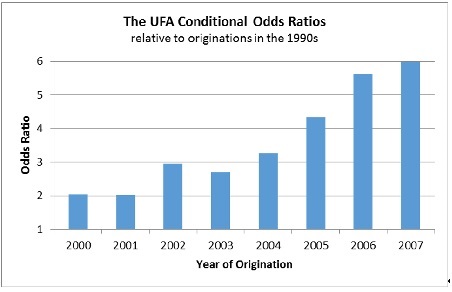
UFA Research: How Bad Did Underwriting Get?
Winter 2016
Recent research from UFA begins to unravel the competing roles of borrower credit, collateral, economic conditions and underwriting quality in the recent mortgage defaults crisis. Because of the importance of loan quality to regulators, investors, rating agencies and insurers, it is imperative to understand how originator lending policies interact with other drivers of default to create the loss characteristics of a pool of mortgages. UFA models default with not only borrower and collateral characteristics, loan terms, and the local and national economic environment, but also with local legal, health and life style characteristics. UFA includes a set of indicator variables for year of origination, and calculates a conditional odds ratio for each origination year. UFA's estimates are summarized in Figure 1-3 below. By 2007, underwriting quality had eroded to the point where private-label loans originated that year were 6 times more likely to default, conditional on all the other variables. That's a key finding of the latest UFA Mortgage Report™ by University Financial Associates of Ann Arbor, Michigan.
“Regulators have tracked borrower credit quality for a long time and more recently have begun to monitor economic conditions more carefully; but can we also track originator exuberance?” said Dennis Capozza, who is Professor Emeritus of Finance with the Ross School of Business at the University of Michigan and a founding principal of UFA. “Our recent research indicates that eroding underwriting quality for private label loans contributed significantly to increased mortgage defaults in the late 2000s."
The UFA Default Risk Index measures the risk of default on newly originated nonprime mortgages. UFA’s analysis is based on a ‘constant-quality’ loan, that is, a loan with the same borrower, loan and collateral characteristics. The index reflects only the changes in current and expected future economic conditions, which are less favorable currently than in prior years.
Each quarter UFA evaluates economic conditions in the United States and assesses how these conditions will impact expected future defaults, prepayments, loss recoveries and loan values for nonprime loans. A number of factors affect the expected defaults on a constant-quality loan. Most important are worsening economic conditions. A recession causes an erosion of both borrower and collateral performance. Borrowers are more likely to be subjected to a financial shock such as unemployment, and if shocked, will be less able to withstand the shock. Fed easing of interest rates has the opposite effect.
UFA’s pioneering mortgage analysis has successfully predicted problems in the mortgage market well in advance including the increased defaults in Southern California in the mid-90s and the recent national mortgage crisis. Its predictions are based on an extensive analysis of local economic conditions in each state and the relationship of those conditions to loan performance. The historical record of millions of mortgage loans is studied each quarter to assess the vulnerability of each state to loan losses and prepayments. The detailed analysis of each state – including best and worst places to lend – is available in the UFA Mortgage Report, published on a quarterly basis.
